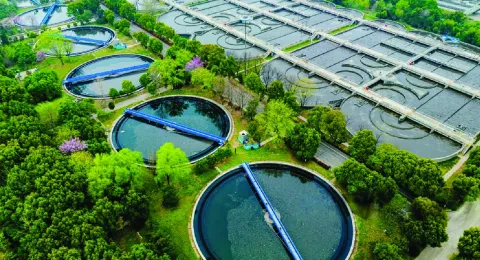Introduction
In the world of water treatment, Effluent
Treatment Plants (ETP), Sewage Treatment Plants (STP), and Wastewater Treatment
Plants (WWTP) are essential for maintaining environmental safety and public
health. These plants must monitor and control several key parameters to ensure
that treated water meets regulatory standards before being released into the
environment. This blog will explore the most important water quality
parameters, including Biological Oxygen Demand (BOD), Chemical Oxygen Demand
(COD), Dissolved Oxygen (DO), Total Suspended Solids (TSS), Liquid Suspended
Solids (LSS), and Total Dissolved Solids (TDS), their definitions, standard
parameters, importance, and measurement techniques.
1. Biological Oxygen Demand (BOD)
Definition:
BOD is a measure of the amount of oxygen required by microorganisms to
decompose organic matter in water. It indicates the level of organic pollution
in the water.
Standard Parameter:
According to the Department of Environment (DOE) standards, treated water
should have a BOD level of less than 30 mg/L.Importance:
BOD is critical for assessing the organic pollution in water. High BOD levels
indicate a high concentration of biodegradable material, which can lead to
oxygen depletion and harm aquatic life.
Measurement:
BOD is measured by incubating a water sample at 20°C for five days and
comparing the oxygen levels before and after incubation.
2. Chemical Oxygen Demand (COD)
Definition:
COD measures the total quantity of oxygen required to oxidize both organic and
inorganic matter in water.
Standard Parameter:
Treated water should have a COD level of less than 250 mg/L according to DOE
standards.Importance:
COD is an essential indicator of water pollution and the effectiveness of
treatment processes. It reflects the potential of water to consume oxygen,
which can impact aquatic ecosystems.
Measurement:
COD is measured by oxidizing the water sample with a strong chemical oxidant
and determining the oxygen consumption using titration or colorimetric methods.
3. Dissolved Oxygen (DO)
Definition:
DO refers to the amount of oxygen dissolved in water, which is crucial for the
survival of aquatic organisms.
Standard Parameter:
The DOE recommends that treated water should have a DO level of at least 4-6
mg/L to support aquatic life.Importance:
DO is vital for maintaining a healthy aquatic environment. Low DO levels can
lead to hypoxic conditions, harming fish and other aquatic organisms.
Measurement:
DO is measured using an electrochemical probe or a colorimetric method, often
done in-situ to ensure accurate readings.
4. Total Suspended Solids (TSS)
Definition:
TSS represents the amount of solid particles suspended in water that can be
trapped by a filter.
Standard Parameter:
Treated water should have a TSS level of less than 100 mg/L according to DOE
guidelines.Importance:
TSS affects water clarity and can carry pollutants such as heavy metals and
bacteria. High TSS levels can lead to sedimentation, clogging, and reduced
light penetration in aquatic systems.
Measurement:
TSS is measured by filtering a water sample through a pre-weighed filter,
drying the filter, and weighing the retained solids.
5. Liquid Suspended Solids (LSS)
Definition:
LSS refers to the smaller particles in suspension that remain in the water
after settling of larger particles. It is a subset of TSS.
Standard Parameter:
LSS should typically be kept as low as possible, though specific standards may
vary based on the application.
Importance:
LSS can contribute to turbidity, affecting water quality and treatment
processes, especially in filtration systems.
Measurement:
LSS can be measured similarly to TSS but may involve additional steps to
separate finer particles.
6. Total Dissolved Solids (TDS)
Definition:
TDS represents the total concentration of dissolved substances, such as salts
and minerals, in water.
Standard Parameter:
The DOE recommends that treated water should have a TDS level of less than 2100
mg/L.Importance:
TDS affects water taste, scaling potential, and overall water quality. High TDS
levels can be harmful to aquatic life and may cause problems in industrial
applications.
Measurement:
TDS is measured using a conductivity meter or by evaporating a water sample and
weighing the residue.
Conclusion
Monitoring and controlling BOD, COD, DO,
TSS, LSS, and TDS are crucial for the effective operation of ETP, STP, and WWTP
facilities. These parameters ensure that treated water meets environmental
standards, protecting aquatic ecosystems and public health. Regular measurement
and adherence to DOE standards are essential for maintaining compliance and
achieving optimal water treatment outcomes.
Aquafit Technology: Your Partner in
Water Treatment
Aquafit Technology is proud to offer
comprehensive water testing services to meet all your needs. We provide
detailed and accurate water test reports, ensuring that you have the critical
information necessary to maintain optimal water quality. Whether it's for
residential, industrial, or commercial purposes, our advanced testing methods
cover a wide range of parameters, including chemical composition, microbial
content, and physical properties. Trust Aquafit Technology to deliver precise
and reliable water test reports, helping you make informed decisions to ensure
the safety and purity of your water.















